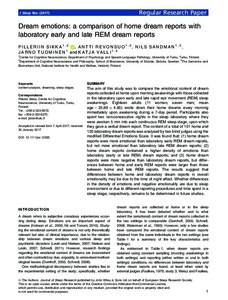Dream emotions: a comparison of home dream reports with laboratory early and late REM dream reports
Pilleriin Sikka; Antti Revonsuo; Nils Sandman; Jarno Tuominen; Katja Valli
https://urn.fi/URN:NBN:fi-fe2021042716805
Tiivistelmä
The aim of this study was to compare the emotional content of dream reports collected at home upon morning awakenings with those collected in the laboratory upon early and late rapid eye movement (REM) sleep awakenings. Eighteen adults (11 women, seven men; mean age = 25.89 ± 4.85) wrote down their home dreams every morning immediately upon awakening during a 7-day period. Participants also spent two non-consecutive nights in the sleep laboratory where they were awoken 5 min into each continuous REM sleep stage, upon which they gave a verbal dream report. The content of a total of 151 home and 120 laboratory dream reports was analysed by two blind judges using the modified Differential Emotions Scale. It was found that: (1) home dream reports were more emotional than laboratory early REM dream reports, but not more emotional than laboratory late REM dream reports; (2) home dream reports contained a higher density of emotions than laboratory (early or late REM) dream reports; and (3) home dream reports were more negative than laboratory dream reports, but differences between home and early REM reports were larger than those between home and late REM reports. The results suggest that differences between home and laboratory dream reports in overall emotionality may be due to the time of night effect. Whether differences in the density of emotions and negative emotionality are due to sleep environment or due to different reporting procedures and time spent in a sleep stage, respectively, remains to be determined in future studies.
Kokoelmat
- Rinnakkaistallenteet [27094]
